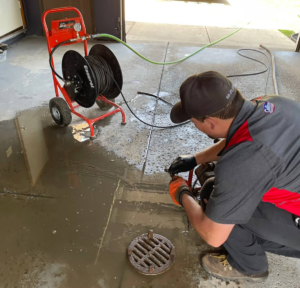Clogged drain lines create the perfect breeding ground for bacteria, fungus and mold that cause foul odors and serious health problems. Professional drain cleaning services use video pipe inspections to determine the best approach to clearing the blockage.
Regular drain cleaning prevents clogs, ensures proper water flow and helps avoid costly repairs and pipe damage. Learn how to keep your drains clean between professional cleanings! Contact Drain Cleaning Perth now!

When you have a clogged drain, your first reaction may be to grab a bottle of liquid drain cleaner from the store. These chemical cleaners, available in gel, crystal, foam and liquid form, usually contain strong bases or acids that dissolve clogs by creating a chemical reaction within the pipe. While these cleaners may be effective at dissolving blockages, they are often dangerous to handle and can cause severe damage to your pipes if misused.
Many liquid drain cleaners are caustic and corrosive. They can eat away at the insides of your pipes, leaving behind holes and leaks. They can also be dangerous to your health, causing chemical burns if they come into contact with your skin or eyes. Some chemical cleaners also release fumes that can irritate your nose, throat and lungs. When exposed to these chemicals over a long period of time, repeated exposure can even lead to brain damage.
Caustic drain cleaners, such as lye and caustic potash, work by giving electrons to the clog material and melting it away. They also create heat as they react with the materials in your pipe, which can soften grease and melt away some types of plastic. Caustic cleaners are heavy and must be poured down the drain slowly to prevent splashing. They can also eat through metal pipes, especially if they are made of galvanized steel, which was commonly used in household plumbing before World War I.
Oxidizing drain cleaners, which are typically found in household bleaches and peroxides, work by allowing the organic material in your pipe to lose its electrons. This chemical reaction oxidizes the molecules and makes them less dense, which helps them to move more easily through your pipe. Oxidizers can be more effective than caustic cleaners on most types of clogs, but they aren’t as safe to use since they can leave your pipe coated with an acidic substance that can promote corrosion.
If you must use a liquid drain cleaner, try to find one that is biodegradable. These products are safer for your pipes and the environment, and they break down clogs with natural enzymes that eat away at the material in your drain. While they may take a little longer to work than chemical cleaners, they are much safer for your health and the environment.
Baking Soda
Baking soda is a common household product that can be used for a variety of cleaning tasks. It is effective at absorbing and dissolving oil, grease and other sticky substances, and it is also an excellent deodorizer. When used regularly, it can help prevent drain clogs by keeping the pipes clean.
One of the most popular DIY hacks for unclogging a drain involves using vinegar and baking soda. This do-it-yourself solution is cheap, easy to find and often works well. However, it is important to understand how this method works and what it can and cannot do.
The vinegar and baking soda reaction creates carbon dioxide gas that dislodges and breaks up clogs. However, this gas can also cause damage to certain types of pipes, especially older copper or brass pipes. Additionally, the acid in vinegar can corrode metal, leading to leaks and other problems down the line.
To use this method, first pour a pot of boiling water down the drain. This will loosen any gunk and grease that is stuck in the drain or pipe. Next, sprinkle about a cup of baking soda over the clogged drain. You can add more baking soda if needed, but make sure to use a non-toxic alternative like sea salt. Wait for the drain to fizz, which should take about an hour. After the fizzing stops, flush the drain with a few cups of hot water to wash away any remaining baking soda and vinegar mixture.
Another option is to combine lemon juice and cream of tartar to make a paste that can be applied directly to the drain. This mixture is effective at breaking down organic clogs, such as hair and food scraps, and it can also dissolve certain types of mineral deposits. Finally, coffee grounds can also be effective if they are mixed with boiling water and allowed to sit for a few minutes before being flushed down the drain.
If you have a severe or persistent clog, it may be necessary to call a plumber. Homemade and DIY drain cleaners are typically effective for minor clogs or routine maintenance, but professional plumbers have the tools and knowledge to handle more stubborn blockages.
Dish Soap
Dish soap is a versatile cleaning product that’s useful for a wide range of household tasks. It’s mild enough to use on many different surfaces, fabrics and materials and can substitute for a variety of other household cleaners (although mixing certain products can create toxic gas, such as using bleach with vinegar). It’s also one of the most cost-effective and environmentally friendly household cleaners.
Most liquid dish soaps contain surfactants, chemical compounds that break down grease and other food residue, and scrubbing agents. Some also have perfumes, dyes and sanitizers. Dish soaps are often sold in recyclable or biodegradable plastic bottles, and some companies offer refills to reduce waste.
While conventional soaps work well, eco-friendly options exist that clean just as effectively and can be found in glass or stainless steel bottles. We like Seventh Generation’s “Lemongrass & Clementine” and “Free & Clear,” which are lightly scented, skin-safe and hypoallergenic. The company is also transparent about its ingredients, uses recycled packaging and doesn’t test on animals.
Other good options include L’Avant Collective’s eye-catching bottle, which looks great on the counter and has a soft, pleasant scent. It’s also biodegradable, and its ingredients are limited. Thrive Market’s dish soap has a lovely light lavender scent, but it’s pricey and not very effective at fighting grease; it requires frequent sponge reloading, and its pump-style dispenser is difficult to use.
Chemical Cleaners
Chemical cleaning is the use of chemicals like acids and minerals to clean surfaces. It is a more effective and efficient method of cleaning than manual methods such as wiping, mopping or scrubbing. It is also less labour intensive. However, one should note that this type of cleaning is very dangerous and requires expert guidance. It involves direct contact with harmful chemicals and can cause serious accidents.
The most common types of cleaning chemicals are abrasives, alkalis and acidic cleaners. Chemicals in the abrasive category remove deposits from hard surfaces by mechanical agitation and friction. They can be very harsh and damaging to some materials including plastics and some metals. Alkali cleaners are very corrosive and destroy bacteria and dissolve proteins. Examples include washing soda (sodium bicarbonate), oven cleaners and lye. They are very dangerous and can burn skin and corrode aluminum products.
Acidic cleaners remove deposits such as scale. These are normally very strong mineral acids and may contain a chelating agent to help in the removal of heavy biological material. Hydrochloric acid is a typical mineral acid used for concrete and vinegar is another example. Sulphuric acid is also found in drain cleaners and removes organic material such as grease and protein.
Detergents are the main component of most cleaning solutions and consist of surfactants, which orient themselves at the interface between water and a soil, and a chelating agent which surrounds unwanted metal ions to prevent them from precipitating out of solution. Detergents are also a good choice for removing combination soils, which have both organic and inorganic components.
When using any cleaning chemicals, read the product label carefully and follow all handling and storage instructions. Never mix different cleaners together and always store them away from heat, sunlight and children. It is a good idea to keep them in sealed and clearly labelled containers. If possible, avoid storing them in old food containers as they might react with residue from the original contents. Also, do not put solvents in the sun as this can evaporate them and make them more dangerous to handle.

